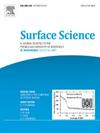Raman scattering in a MoS2 monolayer on quartz from DFT calculations: Effect of the substrate
IF 1.8
4区 化学
Q3 CHEMISTRY, PHYSICAL
引用次数: 0
Abstract
The effect of a quartz substrate on Raman scattering in a molybdenum disulfide monolayer is analyzed within the DFT framework. The Raman spectra were studied for several types of the MoS/SiO2 interface, corresponding to the case of a “dense” SiO2 surface, a surface with defects, roughness and an interface with S![]() O chemical bonds. Calculations show that for the vdW type of MoS/SiO2 interaction, the substrate weakly affects Raman scattering in MoS, except some extreme configurations of the SiO2 surface. In contrast, for interface with S
O chemical bonds. Calculations show that for the vdW type of MoS/SiO2 interaction, the substrate weakly affects Raman scattering in MoS, except some extreme configurations of the SiO2 surface. In contrast, for interface with S![]() O chemical bonds the influence of the substrate becomes much stronger, leading to a noticeable splitting and shift of the and Raman peaks in the MoS monolayer.
O chemical bonds the influence of the substrate becomes much stronger, leading to a noticeable splitting and shift of the and Raman peaks in the MoS monolayer.

石英上二硫化钼单层的拉曼散射:基底的影响
在DFT框架内分析了石英衬底对二硫化钼单层拉曼散射的影响。研究了几种类型的MoS2/SiO2界面的拉曼光谱,分别对应于“致密”SiO2表面、缺陷表面、粗糙度表面和具有SO化学键的界面。计算表明,对于vdW型MoS2/SiO2相互作用,衬底对MoS2中的拉曼散射影响较小,但SiO2表面的某些极端构型除外。相比之下,对于具有SO化学键的界面,衬底的影响变得更强,导致MoS2单层中的E2g1和A1g拉曼峰明显分裂和移位。
本文章由计算机程序翻译,如有差异,请以英文原文为准。
求助全文
约1分钟内获得全文
求助全文
来源期刊

Surface Science
化学-物理:凝聚态物理
CiteScore
3.30
自引率
5.30%
发文量
137
审稿时长
25 days
期刊介绍:
Surface Science is devoted to elucidating the fundamental aspects of chemistry and physics occurring at a wide range of surfaces and interfaces and to disseminating this knowledge fast. The journal welcomes a broad spectrum of topics, including but not limited to:
• model systems (e.g. in Ultra High Vacuum) under well-controlled reactive conditions
• nanoscale science and engineering, including manipulation of matter at the atomic/molecular scale and assembly phenomena
• reactivity of surfaces as related to various applied areas including heterogeneous catalysis, chemistry at electrified interfaces, and semiconductors functionalization
• phenomena at interfaces relevant to energy storage and conversion, and fuels production and utilization
• surface reactivity for environmental protection and pollution remediation
• interactions at surfaces of soft matter, including polymers and biomaterials.
Both experimental and theoretical work, including modeling, is within the scope of the journal. Work published in Surface Science reaches a wide readership, from chemistry and physics to biology and materials science and engineering, providing an excellent forum for cross-fertilization of ideas and broad dissemination of scientific discoveries.
 求助内容:
求助内容: 应助结果提醒方式:
应助结果提醒方式:


